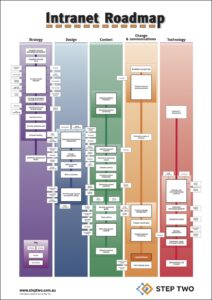
Diverse workers from Shutterstock
Filed under: Articles, Intranets, Knowledge management
Last month’s article Staff interviews as simple knowledge mapping explored the value of conducting one-on-one discussions with staff, when planning knowledge management or intranet projects.
This briefing focuses on just one aspect of the process: who to select for stakeholder interviews. It provides some general guidelines, and then lists some possible areas of the organisation to involve.
Note that the focus of this briefing is on inwards-facing projects, such as an intranet redevelopment or implementing knowledge management systems. Stakeholder interviews for websites, for example, must necessarily include a broader range of participants, such as the public.
Select ‘real’ staff
The most important criteria for stakeholder interviews is to involve actual staff who conducted the day-to-day activities of the organisation, not their managers.
Within most organisations, previous ‘needs analysis’ activities have often involved a range of managers from different areas. While this gathers many opinions about what is required, it rarely reflects the actual needs within the organisation.
For this reason, stakeholder interviews should minimise the number of managers involved, and instead include the broadest possible participation from throughout the organisation.
Involving managers
There are two situations where managers should be involved in stakeholder interviews.
The first is where they are a targeted group of users for the project. In this case, they should be interviewed as individuals (not as mangers of others), exploring their daily work patterns, and their specific needs.
It may also be important to involve managers in order to gain sponsorship and support of the project. In this situation, a different set of questions should be used, to focus on the strategic direction of their section, and how the project may meet those needs.
A list of staff
This section outlines a wide range of possible staff to involve in the stakeholder interviews. It has been presented here, not as a comprehensive list that is applicable in all situations, but as a starting point for your own planning.
The list of stakeholders to include should be determined and refined with the involvement of the team members, project sponsors and other senior staff.
Possible participants:
- Staff involved in key business processes
- The key staff are those who are involved in the most important business processes, whatever those are for your organisation (eg. customer service, sales, manufacturing, research, etc).
- Frontline staff (service desks, call centres)
- Senior staff (CEO, executive)
- Line managers
- Administrative staff
- Personal assistants, secretaries
- Clinical, medical staff (where applicable)
- HR staff
- Librarians
- Records management staff
- IT staff
- Support staff
- Key content owners
- Current intranet managers
- Staff at remote sites
- Off-site staff, or staff in the field
- New starters
- A knowledge resource is most valuable for those in the organisation who don’t yet know how the business operates.
- Long-serving staff
- Customers, or members of the public
While used internally by staff, the information often meets customer needs, or answers questions from the public.





